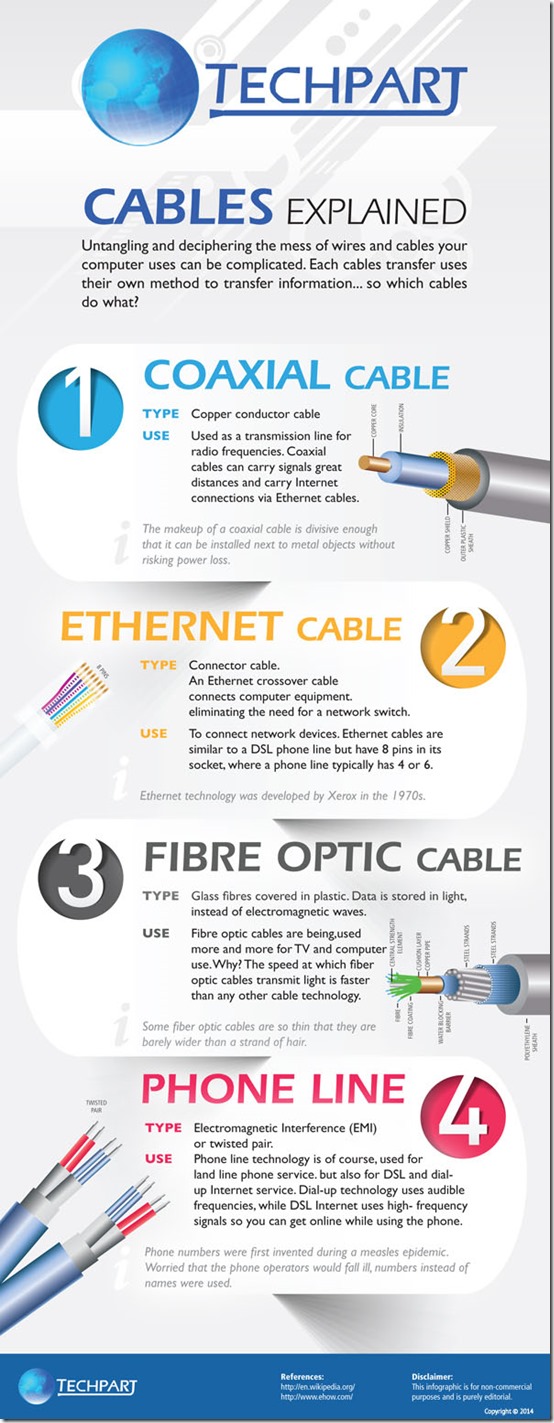Being in the cable business, we are at Techpart decided it would be helpful for our customers and their friends alike if we created an infographic centred around the different type of cables commonly used by you at home, at work and throughout your daily life.
Cables come in many different shapes and sizes, each with their own specific job and method of information transfer. We know it can often be quite difficult to decipher the mess of wires and cables connected to your electrical appliance so we have created this infographic to help you understand a little bit more about what each cable does while you work towards untangling the mess these cables are usually associated with.
Our infographic looks at four different types of cables, the coaxial cable, the Ethernet cable, the fibre optic cable and the phone line. For each cable we have included some information on the type of cable along with some information on what each cable is used for.
Starting with the coaxial cable, this copper conductor cable is used as a transmission line for radio frequencies. Coaxial cables can carry signals great distances and can also carry internet connections via Ethernet cables which we will discuss next. Coaxial cables are made up of an insulated copper core, surrounded by a copper shield and finished in an outer sheath of plastic.
Interesting Fact: The makeup of a coaxial cable is divisive enough that it can be installed next to metal objects without the risk of power loss.
Our next section covers Ethernet cables. Ethernet cables are connector cables. An Ethernet crossover cable is a connector cable that allows you to connect computer equipment. This eliminates the need for a network switch. The main use associated with Ethernet cables is the connection of network devices. Ethernet cables are similar to a DSL phone line but have 8 pins whereas a phone line typically has 4 to 6.
Interesting Fact: Ethernet technology was developed by Xeros in the 1970’s.
Moving onto our next section, we look to cover fibre optic cables and their uses. Fibre optic cables are made up of glass fibres covered in plastic. The difference between fibre optic cables and other cables is that fibre optic cables store data in light, where other cables store data in electromagnetic waves. Fibre optic cables are being used more and more these days for equipment such as TV’s and computers. The reason being, the speeds at which fibre optic cables transmit data is faster than any other cable technology.
Interesting Fact: Some fibre optic cables are so thin that they are barely wider than a stand of hair.
Finally, we come to a cable we are all probably familiar with in the traditional sense, the phone line. A phone line is made up of what is called electromagnetic interference (EMI) or as it is also know, a twisted pair, you can see why if you take a quick look at our infofgraphic. Phone line technology is of course used for land line phone services but also for DSL and dial up internet. Dial up technology used audible frequencies, while DSL internet uses high-frequency signal so you can get online while also using the phone.
Interesting fact: Phone numbers were first invented during a measles epidemic. Worried that phone operators would fall ill, numbers were used in place of names.
We hope all of the above information has been of interest to you and also helped you to understand what exactly those pesky cables running around your home do. If you liked our infographic please feel free to share it as often as you like.


